Welder buying guide
Welder buying guide
Introduction
Buying a welder can be difficult if you don’t know what to look for. Several types are available, all suitable for different uses, and the technical terminology can get confusing.
We’ve put this welder buying guide together to help you. It covers what welders are and how they work. It explains the types of welders, what they are best used for and their pros and cons. It also covers the materials welders can be used for, plus welder features and maintenance. And finally, it highlights some key things to consider when buying a welder and answers some frequently asked questions.

What are Welders?
A welder is a machine that uses a high-powered electrical current to heat and melt metal so that two pieces can be fused together. It can weld metals such as iron, stainless steel and aluminium. Several types of welders are available, such as MIG welders, arc welders, TIG welders and inverted welders.
How do Welders Work?
Different types of welders work slightly differently from each other depending on their welding process, but their basic function is the same:
A metal workpiece is attached to the welder via a ground clamp. Then an electrode is also connected to the welder. When the welder is switched on, the electrode and the metal workpiece have a strong electrical current fed to them through the welding machine. When the welding process starts, the electrode is placed against the metal workpiece to complete an electrical circuit and is then pulled back a few millimetres. When this happens, an electrical arc (like a lightning bolt) jumps through the air from the electrode to the base metal. The extremely hot arc melts the electrode and the base metal, creating a weld pool – a pool of molten metal that will form the joint between the pieces of metal being joined.
Different welders use different types of electrodes to create their electrical arc. For example, the electrode could be a stick electrode or a piece of wire fed through a welding gun.
All welders also have a way of producing a shielding gas, such as argon, helium or carbon dioxide. This protects the metal from reacting with atmospheric gases, which can cause imperfections and damage the quality of the joint. Depending on the type of welder, the shielding gas may be released from a canister, or the electrode can be coated with flux – a material that releases shielding gas as it melts.
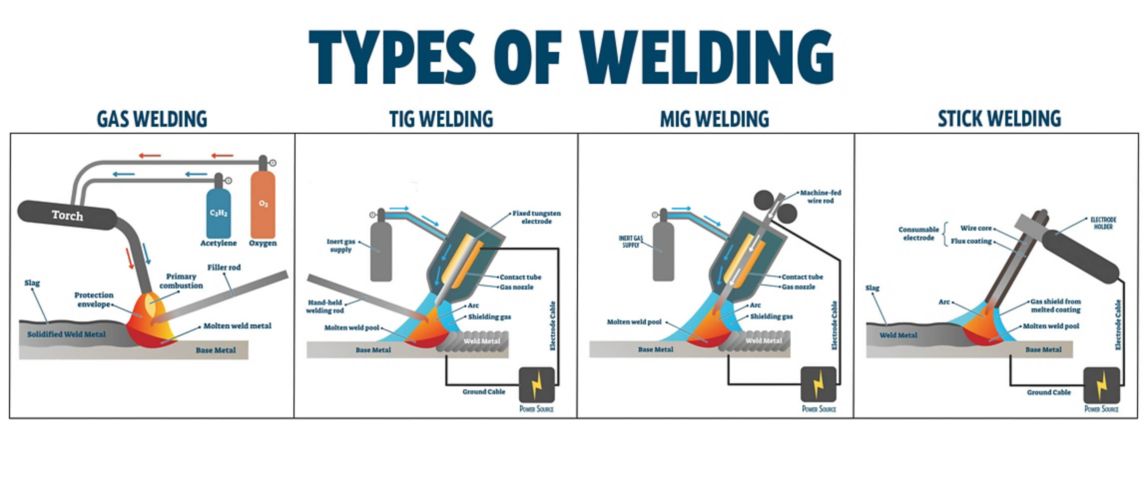
Types of Welder
There are many types of welders available. In this section, we cover the three most popular ones: MIG, Arc and TIG welders, and explain what inverter and MMA welders are.
Each type of welder uses a slightly different welding process. As a result, they require different skill levels and vary in speed, control and the types of materials they can be used to weld.
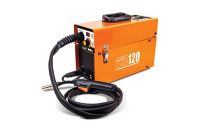
MIG welders explained
MIG is an acronym for Metal Inert Gas. MIG welders work using an arc welding process with a continuous solid wire electrode that’s fed automatically through the welding gun at a constant pre-set speed. The electrode melts with the metal workpiece to create a weld pool that’s used as a filler metal to form the joint.
There are two ways that a MIG welder can produce a shielding gas to protect the weld pool and metal from reacting with airborne contaminants. First, the welding gun can feed gas from a canister alongside the electrode. Or a flux-cored wire electrode containing a shielding gas releasing material can be used.
MIG welders are perfect for beginners because they are easy to use. They produce a neat and clean weld with no slag (waste material), so there's less post-weld cleaning required. They deposit the weld pool at a higher rate than other types of welders, so welding tasks can be completed in less time. And the continuously fed wire electrode means less time is wasted compared to welders, where you must frequently stop to change the electrode. In addition, the flux-cored electrode option works well on dirty or rusty materials, but the continuous wire electrode method requires the base metals to be clean before welding.
There are also a few disadvantages. Such as, the initial set-up and maintenance costs are high. They can only be used in non-draughty conditions (so they can’t be used outside). And they are less efficient if you need to use them for long periods due to their low duty cycle (i.e., the amount of downtime they need to cool down between uses).
MIG welders are best used for joining steel, stainless steel and aluminium in a wide variety of thicknesses.
What gas is needed for a MIG welder?
Argon is the best gas for MIG welding. It can be used on its own or mixed with one or two other gases such as helium and carbon dioxide to allow deeper penetration into the metal.
Are MIG welders AC or DC?
MIG welders use a DC current for welding, providing a smooth welding output, less spatter (metal particles thrown out as it welds), and a more stable arc.
MIG welding diagram
A MIG welder is made up of the following features and functions:
-
Welding machine: this plugs into an electricity supply and feeds the electrical current into the base metal and electrode.
Ground clamp: this is attached to the base metal and is connected to the welding machine by a cable. -
Welding gun: this is connected to the welding machine via a cable.
-
Gas nozzle: this runs through the welding gun to supply the shielding gas. It’s connected to a gas canister.
-
Contact tube: this copper tube runs through the welding gun and supplies the electrode with an electrical current.
-
Consumable electrode: this runs through the contact tube.
Arc: the electrical current that jumps between the electrode and the base metal to create extreme heat. -
Welding pool: the molten pool of metal created by the electrode used to form the joint.
-
Gas shield: the protective layer of gas surrounding the welding pool.
Parent and weld metal: the two pieces of metal which are being joined together.
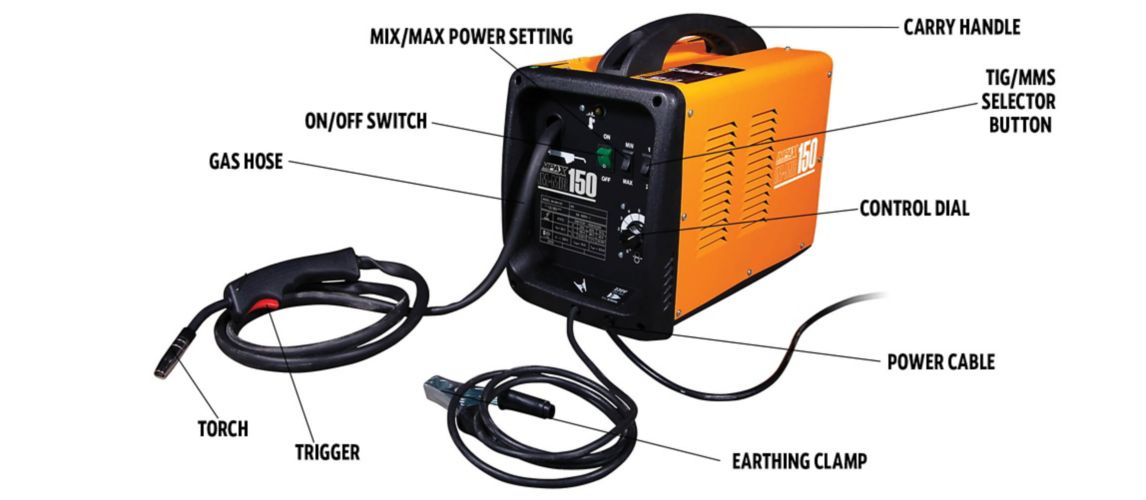
Arc Welders Explained
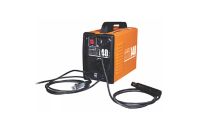
Arc welders are also known as stick welders. They use an arc welding process with a metal stick or rod electrode as a filler metal. The sticks are covered in a flux material that releases a shielding gas as it's melted to protect the molten weld pool from contamination. The sticks are available in different diameters and lengths, and it's essential to use the correct type for your application.
Arc welders are simple to use and easy to learn, so they are ideal for anyone with little welding experience. The arc is not affected by wind, so it can be used outdoors and inside. And they also work well on dirty or rusty metals, meaning no cleaning is required before welding. Another advantage is that the absence of an inert gas supply makes them cheaper to use and easily portable. And the sticks are quick and easy to change, so they're ideal when frequently switching between different welding tasks.
There are a few disadvantages of an arc welder. For example, this type of welding deposits slag (waste material) onto the joint which must be chipped or scraped away as you work. And while the filler stick is easy to replace, it has to be replaced every few minutes. So, constantly stopping work to clean the slag and replace the stick makes working with these welders relatively slow. Arc welders also create more spatter (metal particles thrown out as it welds) than a MIG welder.
Arc welders are best used for joining steel, stainless steel and iron and are designed for jobs such as repairing pipework or equipment or fabricating metal shapes. However, they aren’t suitable for welding metals thinner than 1/8”.
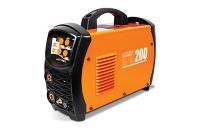
TIG welders explained
TIG is an acronym for Tungsten Inert Gas. It’s similar to a MIG welder, except, instead of using a consumable solid wire electrode as a filler metal, it uses long non-consumable tungsten electrodes to directly fuse two metals together. TIG welding can use both a DC current and an AC current.
TIG welding gives the welder greater control over the process to create a very high-quality weld. However, it's a more complex and difficult process to master than other types of welding and is significantly slower. And, because there's no filler metal, it can only join thin metals. The process doesn't produce any slag to clean away after welding, but the base metals must be very clean and well prepared before the welding starts, as any type of foreign matter will contaminate the weld.
TIG welding can be used for metals such as steel, stainless steel and iron, but it’s best suited to non-ferrous metals such as titanium, aluminium, magnesium and copper alloys.
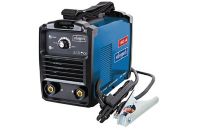
Inverter welders explained
An inverter welding machine is a type of MIG or arc welder. Traditional welders use a transformer to power their engine, whereas modern welders use an inverter. Inverter welders are used to efficiently convert electrical current from AC to a usable DC, more suited to welding. The old transformer power units are cheaper and less complex than an inverter, but they are heavy and overheat more quickly.
The benefits of an inverter welder are that they are smaller and lighter in size and have a higher duty cycle, meaning they can weld for longer periods before needing time to cool down. They are also more efficient to run, and their power can be adjusted to suit different types of welds.
The only downside of an inverter welder is its complex circuit board, so if it fails, the whole board must be replaced.
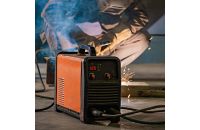
What is an MMA welder?
MMA is an acronym for Manual Metal Arc. An MMA welder works similarly to a MIG or arc welder. But, instead of using an automatically fed wire electrode as a filler metal, it requires the operator to manually apply a filler metal as they weld.
Material Welding can be Used for
Welders can be used to join a variety of different metals. However, different types of welders are better suited to some metals than others.
This section of the welder buying guide covers the most common materials that can be used for welding and recommends which type of welder to use.
|
Type of metal |
Recommended welder type | |||
|---|---|---|---|---|
|
MIG |
Arc |
AC TIG (any thickness) |
DC TIG (any thickness) | |
|
Steel |
✔️ |
✔️ |
✔️ | |
|
Stainless steel |
✔️ |
✔️ |
✔️ | |
|
Aluminium |
✔️ |
✔️ | ||
|
Cast iron |
✔️ (MMA recommended) | |||
|
Brass |
✔️ | |||
|
Copper |
✔️ |
✔️ | ||
|
Chromoly |
✔️ |
✔️ | ||
|
Titanium |
✔️ | |||
|
Magnesium alloys |
✔️ | |||
Welders Features Explained
This section of the welders buying guide covers some of the features and terminology to be aware of when buying a welder.
- Wire feed speed
This feature refers to the speed at which the filler metal is fed into a weld (i.e., the continuous solid wire electrode on a MIG welder or the stick electrode on an arc welder). It is measured in inches per minute (in/min) or millimetres per second (mm/s). The higher the speed, the higher the amperage the machine will be. - Arc
This is the visible arc of electricity that jumps between the electrode and the base metal when welding. - Flux
This is a coating on arc-welding rods and flux-corded welding wire. As the rod or wire melts, the flux releases a shielding gas that protects the metal weld pool from airborne contaminants. - Shielding gas
This is a protective gas (usually argon, helium or carbon dioxide) used in welding that protects the metal from reacting with atmospheric gases, which can cause imperfections and damage the quality of the joint. - Spatter
This is the term used for droplets of molten metal thrown from the weld pool during the welding process. They cool and harden on the surfaces they land on. - Torch
This is another name for the hand-held welding gun. The device delivers the electrical current to the electrode to create an arc when it’s placed near the base metal. - Slag
This is the waste material produced while welding using a flux coated electrode.
Welding Machine Maintenance
Proper care and maintenance of a welder will ensure it runs safely, performs well, increases its lifespan and prevents it from breaking down.
Here are some essential maintenance tasks:
-
Blow out or vacuum the interior of the machine at least once every six months.
-
Check and clean the wire feeder, drive rolls and the inlet and outlet guide at least every three to four months and replace them when necessary.
-
Have the welder professionally serviced at least once per year.
-
Inspect and replace any worn cables at least once per month.
-
Inspect circuit breakers and interlocks once a month to ensure they are working correctly.
-
Store gas cylinders in an upright position in a cool and dry environment.
-
Inspect and test gas cylinder regulators and valves at least once every six months to ensure there are no leaks.
-
Coil up the hoses while they are being stored to prevent damage from kinks.
Key Considerations when Buying a Welder
We’ve covered the most essential information you need to know in this welder buying guide, but there are a few more things to consider before buying.
-
What safety and protection do you need?
Welding is a high-risk task, so precautions must be taken to reduce the risk of injury and fire. For example, carry out welding in a safe location, at least 10m away from any flammable materials. The areas should be well ventilated to remove air contaminants and prevent the accumulation of flammable or combustible gases or vapours that could cause a fire or be breathed in. Finally, wear appropriate PPE such as a welder’s hood, thick long-sleeved tops and trousers to cover the skin, respirators and gloves. -
What is the duty cycle needed?
A welding machine’s duty cycle is the number of minutes out of a ten-minute period that the machine can operate continuously before it overheats. The duty cycle is expressed as a percentage at a given amperage. So, for example, a 100-amp welder with a duty cycle of 70% means that in each ten-minute period, it can run continuously for seven minutes and will then need to cool down with the fan running for three minutes before it can be used again. The duty cycle you need will depend on the type of work you will be doing. For example, a welder in a garage will likely stop welding more frequently than a welder working in manufacturing or fabrication. Therefore, a lower duty cycle will cover most tasks. -
What rated output is needed?
The output power of a welding machine is measured in amps. A welder operating at high amperage will heat faster, but the duty cycle will be reduced. And if the amperage is low, the duty cycle increases. The rated output you need will depend on the type of welding you will be doing.
